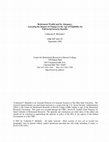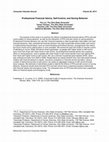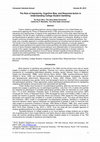Papers by Catherine P Montalto
Econometric Modeling: Theoretical Issues in Microeconometrics eJournal, 1996
The 1992 Survey of Consumer Finances consisted of five complete data sets because missing data ar... more The 1992 Survey of Consumer Finances consisted of five complete data sets because missing data are multiply imputed. The incidence of missing data in the 1992 SCF is addressed and illustrates the difficulty of obtaining financial information from individuals. The value of using all five data sets and the risk of using only a single data set in empirical research are explained. Estimates derived separately from each data set are compared to results using all five data sets to illustrate the extra variability in the data due to imputation. Researchers are encouraged to use information from all five data sets in order to make valid inferences.
Journal of Economic Psychology, 2010

Financial Services Review, 2002
We examine the use of financial planners by U.S. households using data from the 1998 Survey of Co... more We examine the use of financial planners by U.S. households using data from the 1998 Survey of Consumer Finances and find that over one-fifth (21.2%) of households use financial planners. A small portion of households (2.7%) obtain advice from financial planners on only credit or borrowing, whereas 11.5% look for recommendations on only saving or investing issues, and 7.0% obtain comprehensive advice (i.e., credit or borrowing and saving or investing). The use of financial planners by households varies by financial and sociodemographic characteristics of the household, and the effects of these characteristics vary by category of use (i.e., credit/borrowing only, saving/investing only, comprehensive advice). © 2002 Academy of Financial Services. All rights reserved. JEL classification: D12; D81; G20 Keywords: Personal financial planning; Financial planners; Survey of Consumer Finances 1. Introduction The field of personal financial planning (PFP) is growing. A recent CFP Board survey...
Repeated-imputation inference (RII) techniques for estimating nonlinear models with multiply impu... more Repeated-imputation inference (RII) techniques for estimating nonlinear models with multiply imputed data are described. RII techniques are used to estimate a logit model using the 1995 Survey of Consumer Finances. RII techniques use all information available in multiply imputed data and incorporate estimates of imputation error. The advantage of RII techniques for analysis of multiply imputed data is that RII techniques produce more efficient estimates and provide a basis for more valid inference. Researchers who do not use RII techniques when estimating nonlinear models on multiply imputed data may incorrectly conclude that some independent variables have statistically significant effects.
Household Finance eJournal, 2003
The relationship between meeting the Capital Accumulation Ratio Guideline and retirement adequacy... more The relationship between meeting the Capital Accumulation Ratio Guideline and retirement adequacy was investigated. About 63% of the households had a consistent relationship between meeting the 25% ratio guideline and being adequately prepared for retirement, with 46% of households both meeting the 25% ratio guideline and being prepared for retirement and 17% not meeting the guideline and not being adequately prepared for retirement. However, 37% of households did not have a consistent relationship. Meeting the 25% ratio guideline does not appear to be an accurate indicator of retirement adequacy. The 25% guideline was a better indicator than the 50% guideline.
Microeconomics: Intertemporal Consumer Choice & Savings eJournal, 2006
The Survey of Consumer Finances was used to assess the explanatory power of self-control mechanis... more The Survey of Consumer Finances was used to assess the explanatory power of self-control mechanisms, controlling for other important constructs from the standard life cycle model of saving. The analysis focused on saving goals, foreseeable expenses, and saving rules as mechanisms of self-control. Household saving behavior was strongly affected by mechanisms that help households practice self-control. Households that had saving rules were much more likely to spend less than income than those that did not have saving rules.
If married women view participation in the labor force as providing insurance against the negativ... more If married women view participation in the labor force as providing insurance against the negative economic consequences of divorce, then married women with higher expectations of divorce will be more likely to be employed. The Panel Study of Income Dynamics, 1968-1983, is used to estimate the effect of the expectation of divorce on the labor force participation decision of married women. The longitudinal nature of the data is used to estimate the probability of divorce for each married woman in the sample. Labor force participation is then modelled as dependent on the individual's expectation of future divorce. The empirical results confirm that expectation of divorce increases labor force participation of married women.
The likelihood of meeting the three-month expenditure guideline for monetary, comprehensive, and ... more The likelihood of meeting the three-month expenditure guideline for monetary, comprehensive, and subjective emergency funds is examined using data from the 1998 Survey of Consumer Finances. Specific independent variables of interest include the household’s attitude towards credit, whether the household overspent, the expectation of future income, the working status of the spouse, and alternatives to emergency funds. Results suggest the actual emergency fund level held by households is more closely related to the ability to save than to the need for emergency funds. A home equity line of credit may be a feasible alternative to emergency funds. © 2004 Academy of Financial Services. All rights reserved.

The capital accumulation ratio, investment assets divided by net worth, has been proposed as a us... more The capital accumulation ratio, investment assets divided by net worth, has been proposed as a useful indicator of financial health. Various experts recommend a minimum value of 25% to 50% for the ratio. When certificates of deposit are not counted as investment assets, 56% of U.S. households meet the 25% guideline and only 40% meet the 50% guideline. In a multivariate logistic regression, education, income, number of years until retirement, overspending, and financial risk tolerance are positively related to meeting the guidelines. © 2002 Academy of Financial Services. All rights reserved. JEL Classification: D9; G29 Keywords: Capital accumulation ratio; Financial ratios; Retirement adequacy 1. Introduction Financial ratios can provide a convenient way to diagnose the financial status of households (Greninger et al., 1996). Financial ratios provide numerical objective yardsticks designed to help simplify the judgmental assessments of current financial strength and changes over time...
The bearing device 4 is press-fitted between the inside surface of the axis insertion hole of a s... more The bearing device 4 is press-fitted between the inside surface of the axis insertion hole of a steering column and the outside surface of a steering axis inserted into the axis insertion hole so as to support the steering axis. The bearing device 4 comprises a roller bearing arranged on the outside surface of the steering axis and a spacer ring arranged between the outside surface of the roller bearing and the inside surface of the axis insertion hole. The spacer ring comprises a wall thickness holding unit for holding the thickness of its wall in the radius direction and a thickness reduction unit which is provided on at least one site of the inside and outside surfaces and its end in the vicinity of the wall thickness holding unit and which reduces the thickness of the wall to facilitate deformation of the spacer ring.
This study analyzes factors associated with anticipated difficulty with repayment of debt accumul... more This study analyzes factors associated with anticipated difficulty with repayment of debt accumulated during college using a basic model of credit risk that includes socialization processes influencing college student financial decisions. The empirical analysis uses data from the 2010 Ohio Student Financial Wellness Study. Results provide evidence of male overconfidence in financial decision making, as males are less likely than females to predict repayment difficulties. Socialization process variables, including financial management practices, financial parenting communication, and expected economic returns from education, are strongly associated with anticipated debt repayment difficulty. Inclusion of these process variables in the model results in loss of explanatory power of many of the traditional individual success variables, such as gradepoint average, and graduation plans.
This study used Grossman’s model of demand for health to examine Complementary and Alternative Me... more This study used Grossman’s model of demand for health to examine Complementary and Alternative Medicine (CAM) use by consumers in the U.S. Main objectives of this study were to identify the predictors of demand for CAM and to examine whether CAM and conventional care are economic substitutes or complements. Data used for this study were from the 2002 and the 2004 Medical Expenditure Panel Survey. Health insurance coverage for conventional care, presence of children under age 18 in household, hours of employment, wages, age, chronic conditions, age, gender, race/ethnicity, and risk tolerance predicted probability and level of CAM use. The positive cross-price elasticity of physician visits in chiropractic and acupuncture and/or massage model suggests substitution of CAM for conventional care. Implications for consumer well-being and health care policy are delineated.

This paper assesses whether the accumulated retirement wealth of pre-retirees will be adequate to... more This paper assesses whether the accumulated retirement wealth of pre-retirees will be adequate to cover needs during retirement, and how variation in age of eligibility for Social Security benefits affects adequacy. Data from the 1998 Survey of Consumer Finances are analyzed to assess the adequacy and composition of retirement wealth of U.S. households, and simulations are used to assess the impact of changes in the Social Security system. Unique contributions of the research include use of household specific information on portfolio allocation and planned retirement age, projection of retirement wealth using asset specific growth rates, and estimation of retirement needs based on household expenditure functions. The findings reveal that the average U.S. household receives approximately 46% of retirement wealth from Social Security, 39% from personal savings, and 14% from pensions. Approximately 56% of U.S. households are on track to be able to maintain their pre-retirement consumpt...

The purpose of this study is to examine the effects of professional financial advice (PFA) and se... more The purpose of this study is to examine the effects of professional financial advice (PFA) and selfcontrol ability on saving behavior, as well as the interaction of PFA and self-control on saving behavior. Professional financial advisors can use their financial expertise to help households make better informed financial decisions. Also, professional financial advisors may help households achieve better self-control in implementing financial plans, such as recommending commitment devices, arrangements that restrict the future choice set by setting plans or even penalties. We extend the dual-self model of impulse control (Fudenberg & Levine, 2006) and derive three hypotheses: (a) people with higher levels of self-control save more than those with lower levels of self-control, (b) professional financial advice has a positive effect on saving behavior, and (c) people with lower levels of self-control benefit more from getting PFA than those with higher levels of self-control. We use a German household panel dataset SAVE, which was collected annually from 2005 to 2009. Respondents are asked whether they have discussed financial matters with financial advisors in banks, insurance companies or financial service providers. Using a number of behavioral proxies of self-control, we create an aggregate measure of self-control through factor analysis. We estimate a fixed-effects model to identify the effects of PFA and self-control on saving behavior. Empirical results show that both PFA and self-control have a significant positive relationship with financial assets and emergency funds. The interaction term for PFA and self-control has a significant effect on financial assets and emergency funds.

Complementary health practice review, 2006
Determinants of complementary and alternative medicine (CAM) use and characteristics of users are... more Determinants of complementary and alternative medicine (CAM) use and characteristics of users are examined using a sample of 848 adults aged 50 and older from the 2000 Health and Retirement Survey. Logistic regression is used to identify the factors associated with the likelihood of using CAM. Nearly 70% of the respondents use at least one CAM modality, with 44% reporting use of curative CAM and 58% reporting use of preventive/curative CAM. Whites, relative to Blacks, were more likely to use curative and less likely to use preventive/curative CAM. Widowed older adults were more likely to use preventive/curative CAM. Number of limitations in activities of daily living was positively associated with use of both types of CAM. Recommendations are made for improving research on alternative health care utilization, for educating CAM users, and for qualitative studies to gain further insight into factors affecting the use of specific CAM modalities.

Journal of Youth Studies, 2014
Factors related to gambling behavior among college students in the United States are examined by ... more Factors related to gambling behavior among college students in the United States are examined by applying the Theory of Reasoned Action (TRA) and incorporating the concepts of impulsivity and cognitive bias. A majority of the respondents (84.4%) in this study report that they did not gamble in the last 30 days. Gambling is modeled as economic behavior where rational individuals are hypothesized to gamble in order to maximize their utility subject to constraints. Building on recent studies confirming correlation between gambling, financial management, and financial behavior, this study uses a broader approach to analyze gambling behavior by including financial behavior variables. The results of the OLS regression analysis indicate that gambling frequency is strongly related to attitudes toward gambling and cognitive bias toward gambling and weakly associated with subjective norms of family members regarding financial behavior and underestimation of financial behavior. The results of the Logistic regression analysis suggest that gambling propensity is strongly related to attitudes toward gambling, subjective norms of family members regarding financial behavior, and cognitive bias toward gambling. The empirical work finds only weak evidence that impulsivity is associated with gambling propensity.
The likelihood of meeting the three-month expenditure guideline for monetary, comprehensive, and ... more The likelihood of meeting the three-month expenditure guideline for monetary, comprehensive, and subjective emergency funds is examined using data from the 1998 Survey of Consumer Finances. Specific independent variables of interest include the household's attitude towards credit, whether the household overspent, the expectation of future income, the working status of the spouse, and alternatives to emergency funds. Results suggest the actual emergency fund level held by households is more closely related to the ability to save than to the need for emergency funds. A home equity line of credit may be a feasible alternative to emergency funds.










Uploads
Papers by Catherine P Montalto